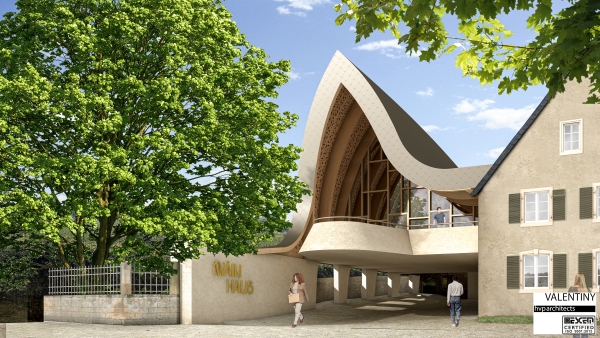 Credit: Valentiny hvparchitects
Credit: Valentiny hvparchitects
On Monday 10 October 2022, Luxembourg's Minister of Tourism, Lex Delles, together with officials from the Public Building Administration and the Luxembourg Moselle Tourist Agreement, presented the Wäinhaus (“wein house”) project in Ehnen, a small town in the south-east of Grand Duchy and home to Luxembourg's Moselle Wine Museum.
Redevelopment and extension of the “Wäinhaus” project
The purpose of the redevelopment and extension project is the creation of the “Waïnhaus” in Ehnen, which respects the architecture and character of the old buildings of the Wellenstein, Schëntgen and Kelterhaus houses, classified as national monuments.
The site includes the mansion, wine annexes and interior courtyards forming an architectural diversity and a remarkable urban composition. The existing protected buildings from the 16th and 18th centuries will be transformed and renovated.
The new construction will include a reception area with its bistro for a capacity of 50 people.
Inside, the framework will remain visible and will form with the wooden coverings a warm space for the bistro. Two large bay windows will allow the view of the Moselle and the interior courtyard.
The overall cost of this redevelopment and extension project amounts to €9.5 million (including tax).
The new name of the “Wäinhaus” centre, a reference wine tourism site
Wine is the common denominator that unites the Moselle region. It is not only part of the Luxembourg identity but also a crucial element of the tourist offer. The creation of the “Wäinhaus” wine experience centre offers an exceptional showcase for the wine sector and is a flagship project for the promotion of wine tourism, one of the priorities of the new tourism strategy of the Directorate General for Tourism.
The development of the “Wäinhaus” concept was characterised by a collaborative approach. The choice of the new name was thus the subject of a participatory process. Within the framework of several workshops, including local actors such as the Luxembourg Moselle Tourist Agreement, the Regional Office of Tourism "Visit Moselle", the Viti-vinicole Institute, the viticultural interprofession, the European group of economic interest Terroir Moselle, the local action group LEADER Miselerland and the former Wine Museum, the name “Wäinhaus” was agreed upon. This term brings together two founding elements, namely the “Haus” (house), therefore the family place and the know-how, as well as the “Wäin” (wine). The expression "homemade" indeed values the know-how of a craftsmanship that produces on site from raw products. In addition, the name "Wäinhaus" is easily understandable internationally, while retaining its linguistic origin. To affirm and accentuate the unique value of the “Wäinhaus” brand, a dedicated typography has been designed, in order to graphically symbolise the biological and organic character inspired by the culture and science of wine.
The future exhibition, a showcase of 1,300 m2 on the region and its wine
Regarding the future exhibition of the "Wäinhaus", it is clear that it will be a showcase of approximately 1,300 m2 on the region, its particularities, its character and its wine. Visitors will be able to test their senses, attend workshops, meet those who devote themselves every day to wine production, document themselves in the “Liesstuff” and find good bottles, as well as advice in the “Wäibuttéck”. It is therefore not only an exhibition site but also a place for the exchange of knowledge and know-how. A place of meeting and inspiration for tourists, as well as for residents and economic actors of the region. A place of departure also, to discover the region and to meet the winegrowers.
The Luxembourg Moselle Tourist Agreement, in collaboration with the General Directorate of Tourism, will also develop with the three high schools in the Moselle region (Maacher Lycée, International School of Mondorf-les-Bains and the Schengener-Lycée) an artistic project. This will be used to thank the donors of the objects that were exhibited in the first exhibition circuit of the Wine Museum through a sculpture. The sculpture made from various viticultural objects made available will be exhibited in the “Wäinhaus” circuit. Léon Gloden, President of the Luxembourg Moselle Tourist Entente, underlined in this context that he was delighted with such synergy and collaboration between the “Wäinhaus” and the three high schools: “A first in the region! Especially since the production will be integrated into the tour circuit. This project will also allow students to immerse themselves in the 'Moselle region' and arouse an interest in its culture."
Minister Delles said: “The 'Wäinhaus' underlines the great potential of wine tourism, which is part of the political priorities of the Directorate General for Tourism and which is a key element of the new tourism strategy. This approach aims to effectively exploit the tourist potential of the Moselle region and to promote its tourist development. The 'Wäinhaus', as a wine tourism reference site, will make it possible to make more residents and foreign tourists aware of the Moselle region, which will ultimately strengthen Luxembourg's viticulture”.
The reopening of the “Wäinhaus” can be considered a few months after the completion of the construction project by the Public Building Administration, i.e. towards the end of the first half of 2025.








